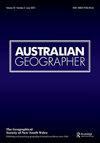了解covid -19引发的区域迁移中的“区域”:跨分类系统绘制凯恩斯地图
IF 2
2区 社会学
Q2 GEOGRAPHY
引用次数: 5
摘要
本文剖析了当前COVID-19移民辩论中“区域”的概念,以了解昆士兰州凯恩斯市如何适应澳大利亚更广泛的城乡内部移民地理。它揭示了“区域”的不同结构,展示了它们如何经常表达“访问”,“农村”和“偏远”以及非城市实体的一般意义。我们讨论了澳大利亚不同区域分类系统的想象地理,如澳大利亚统计地理标准(ASGS),农村,偏远和大都市地区(RRMA)和修正莫纳什模型(MMM)。我们展示了如何以特定的方式构建“区域”的定义和分类,以解决诸如经济发展、卫生、移民和更广泛的决策议程等政治和社会问题。部署的分析为理解2019冠状病毒病时期与向凯恩斯移民相关的区域性关键方面提供了一个框架。批判性的解释性分析有助于阐明与澳大利亚最近的城乡内部移民辩论相关的地点/环境的重要性,但也为反城市化辩论提供了关于取代“乡村田园”概念的见解。本文章由计算机程序翻译,如有差异,请以英文原文为准。
Understanding the ‘region’ in COVID-19-induced regional migration: mapping Cairns across classification systems
ABSTRACT This paper unpacks the notion of ‘region’ in the current COVID-19 migration debate to understand how the city of Cairns, Queensland fits into a wider geography of internal urban-rural migration in Australia. It unpacks different constructions of ‘region’, showing how they often articulate ‘access’, ‘rural’ and ‘remote’ and a general sense of non-urban entities. We discuss the imagined geographies of different Australian regional classification systems such as the Australian Statistical Geography Standard (ASGS), Rural, Remote and Metropolitan Area (RRMA) and Modified Monash Model (MMM). We show how definitions and classifications of ‘region’ are constructed in particular ways to address political and social issues such as economic development, health, immigration and wider policy-making agendas. The analysis deployed develops a framework for understanding key dimensions of regionality relevant to migration to Cairns in the COVID-19 moment. A critical interpretive analysis helps shed light on the importance of place/context in relation to Australia’s recent urban--rural internal migration debate, but also provides insights to the counter-urbanisation debate in terms of displacing notions of the ‘rural idyll’.
求助全文
通过发布文献求助,成功后即可免费获取论文全文。
去求助
来源期刊

Australian Geographer
GEOGRAPHY-
CiteScore
4.10
自引率
8.30%
发文量
33
期刊介绍:
Australian Geographer was founded in 1928 and is the nation"s oldest geographical journal. It is a high standard, refereed general geography journal covering all aspects of the discipline, both human and physical. While papers concerning any aspect of geography are considered for publication, the journal focuses primarily on two areas of research: •Australia and its world region, including developments, issues and policies in Australia, the western Pacific, the Indian Ocean, Asia and Antarctica. •Environmental studies, particularly the biophysical environment and human interaction with it.
 求助内容:
求助内容: 应助结果提醒方式:
应助结果提醒方式:


